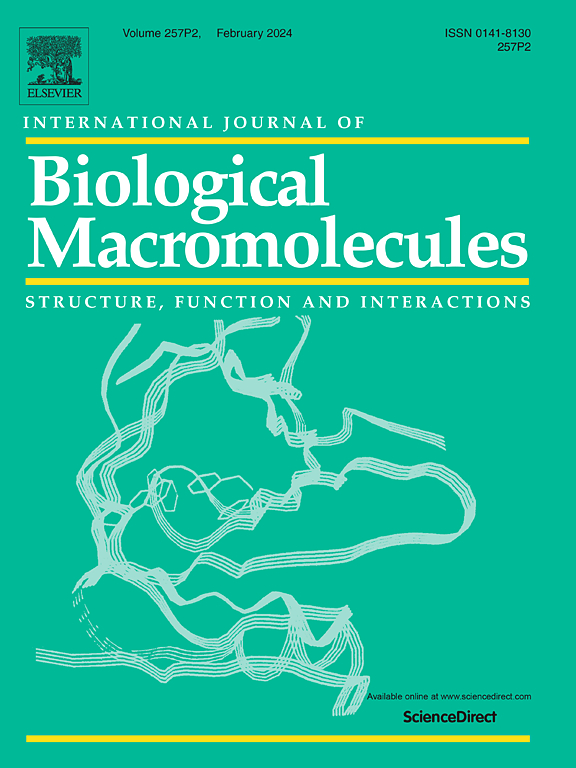从桦树、小麦和燕麦中提取的木质素具有广泛的抗菌活性
IF 7.7
1区 化学
Q1 BIOCHEMISTRY & MOLECULAR BIOLOGY
International Journal of Biological Macromolecules
Pub Date : 2025-07-04
DOI:10.1016/j.ijbiomac.2025.145736
引用次数: 0
摘要
我们研究了用加压热水萃取法去除半纤维素后,用温和碱性程序从桦木片、麦秸和燕麦壳中分离出的水基木质素溶液。所有木质素样品对所测非包膜肠病毒和包膜冠状病毒均有抗病毒作用。桦树木质素对肠道病毒的防治效果最好,麦秸木质素对肠道病毒的防治效果差不多,而燕麦木质素的防治效果要差得多。这可能是由于桦树和小麦中总酚含量较高,桦树中紫丁香基含量最高。详细的力学研究证实木质素处理稳定了CVA9结构并导致病毒聚集。木质素处理后的CVA9仍能结合并进入细胞,但不能在细胞内进行复制。与稳定肠道病毒相反,木质素处理破坏了冠状病毒的结构,从而抑制了病毒的进入和感染。所有木质素样品均能显著延缓革兰氏阳性金黄色葡萄球菌的生长,降低革兰氏阴性大肠杆菌的种群密度。此外,两种菌株的形态都发生了变化。总之,木质素表现出广泛的抗菌功效,直接作用于微生物。结果进一步表明,微生物之间的功效差异可能基于微生物的结构差异,但也基于不同来源木质素的结构差异。本文章由计算机程序翻译,如有差异,请以英文原文为准。
Aqueous-based lignin extractions from birch, wheat, and oat exhibit broad antimicrobial activities
We studied aqueous-based lignin solutions from birch chips, wheat straw, and oat husks isolated with a gentle alkaline procedure after hemicellulose removal using pressurized hot-water-extraction. All lignin samples showed antiviral efficacy against tested non-enveloped enteroviruses and enveloped coronaviruses. Lignin from birch chip showed greatest efficacy against enteroviruses while wheat straw was almost as efficient but oat much less efficient. This is likely due to higher total phenolics in birch and wheat and highest syringyl content in birch. The detailed mechanistical studies confirmed that lignin treatment stabilized CVA9 structure and led to virus aggregation. Lignin-treated CVA9 could still bind and enter cells but did not proceed with replication in cells. In contrast to stabilization of enteroviruses, lignin treatment damaged the coronavirus structure leading to inhibition of viral entry and infection. All lignin samples significantly delayed the growth of Gram-positive Staphylococcus aureus and reduced the population density of Gram-negative Escherichia coli. Furthermore, morphological changes could be observed for both bacterial strains. Altogether, lignins demonstrated broadly acting antimicrobial efficacy, acting directly on the microbes. The results further suggest that differences in efficacy among microbes are likely based on structural differences of microbes but also structural differences of lignins from different sources.
求助全文
通过发布文献求助,成功后即可免费获取论文全文。
去求助
来源期刊
CiteScore
13.70
自引率
9.80%
发文量
2728
审稿时长
64 days
期刊介绍:
The International Journal of Biological Macromolecules is a well-established international journal dedicated to research on the chemical and biological aspects of natural macromolecules. Focusing on proteins, macromolecular carbohydrates, glycoproteins, proteoglycans, lignins, biological poly-acids, and nucleic acids, the journal presents the latest findings in molecular structure, properties, biological activities, interactions, modifications, and functional properties. Papers must offer new and novel insights, encompassing related model systems, structural conformational studies, theoretical developments, and analytical techniques. Each paper is required to primarily focus on at least one named biological macromolecule, reflected in the title, abstract, and text.

 求助内容:
求助内容: 应助结果提醒方式:
应助结果提醒方式:


